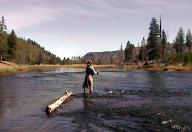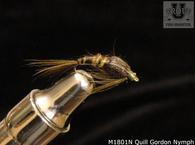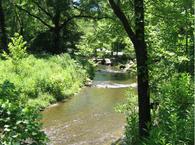The Madison River originates at the junction of the Firehole and Gibbon rivers in the northwestern corner of Yellowstone Park. The Madison River follows casually along Yellowstone National Park’s West Entrance Road for about 14 miles before exiting the park. From there, the Madison continues 130 miles to the Three Forks of the Missouri.

While in the park, the Madison River has some huge beds of aquatic weeds, and deep undercut banks to provide cover and holding places for the trout as they wait to ambush food from the prolific insect hatches as well as the terrestrials.
The first section of the Madison River near the Madison River Campgrounds is by far the warmest water and supports prolific hatches of mayflies and caddis flies. The trout in this portion are plentiful and will average as large as any other place in the park. A couple of miles down the Madison beyond the riffles is a meadow section where the river splits around islands. Weeds, deep undercut banks and potholes in the bottom provide excellent holding for large trout.
Further down the road you come upon Nine Mile Hole which is a section of the river with a steeper gradient and larger boulders. (It is named Nine Mile Hole because it is nine miles from the entrance to the park.) Anglers who don’t mind a wading challenge can find this section rewarding for large trout. Trout in this portion may run a bit larger. From lower Nine Mile Hole to Seven Mile Bridge is a huge dangerous marsh where you can step in over your waders in potholes, along the bank as well as out in the stream so caution is necessary.
Proceeding along the
West Entrance Road you will find several pullovers with access to the river. In the September and October months, fish large streamers size #2 to #6 down and across as you move cautiously downstream. Browns in the 16 to 18 inch range are occasionally caught.
Fishing pressure along this portion of the Madison River can indeed be heavy especially early in the fishing season, since many of the other streams have not yet shed their spring runoff. Expect to share the river with several other anglers during the June hatches, which is the best time for the Madison.
Fishing the Madison:
The Madison is fed by the
Firehole River and will have warmer water in the months of July and August so the trout will tend to be smaller and somewhat lethargic. It is interesting to note that multiple hatches may occur at the same time, but some of the more predominant hatches are the Giant Stone Fly and the Yellow Stone fly which form a good portion of the trout’s food. The nymphs of these flies live in the water for a long time and can become large. Also there are several mayfly hatches and caddis fly hatches as well. In some portions of flat water, dry flies will be productive especially near the undercut banks in the meadows. In the fast water portions, fish with a 6 WT rod, sinking line (Hi-D), and a leader of two feet, and weight it accordingly to reach deep. In October, use streamers like the
sculpin imitations or the wooly buggers.
Late Spring and Early Summer:
Early spring fishing can be accomplished when the season first opens and before the runoff has started; however, the fishing on the Madison will be good starting the last week of May or early June. The Blue Winged Olives, and the Pale Morning Duns in hook sizes #16 through #20 will be effective in most cases. Later in mid June, the abundant hatches of the Salmon Fly, Giant Stone Fly, Yellow Stone Fly, and the golden Stonefly present excellent opportunities to fish with the large weighted nymph patterns.
Summer:
Summer is the least favorite time to fish the Madison due to the warm water supply. However, with the fishing pressure reduced greatly, the patient angler can be rewarded by fishing imitations of the Little Green Drake and the Little Sister Caddis.
Fall:
September and especially October present an excellent time to fish the Madison River. Start in September with the Tricos and the Blue Winged Olive patterns. In the September and October months, fish large streamers down and across as you move cautiously downstream. Be sure to try the terrestrial patterns like hoppers and place them in the current line near the undercut banks where the browns will be waiting for the wind to carry them into the water.

 While in the park, the Madison River has some huge beds of aquatic weeds, and deep undercut banks to provide cover and holding places for the trout as they wait to ambush food from the prolific insect hatches as well as the terrestrials.
While in the park, the Madison River has some huge beds of aquatic weeds, and deep undercut banks to provide cover and holding places for the trout as they wait to ambush food from the prolific insect hatches as well as the terrestrials.




